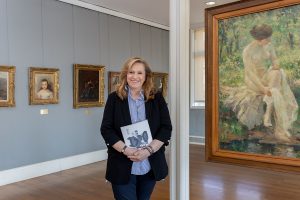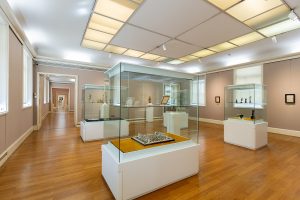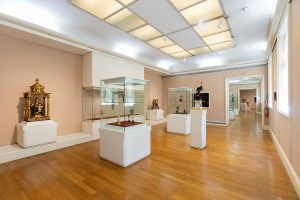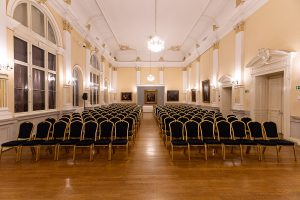The Mimara Museum’s programme is full until the spring of 2021. Is there a better recommendation to visit the museum than this one? It’s not an easy task for Lada Ratković-Bukovčan, director of the Mimara Museum, to count every item worth seeing in this museum because, in more than three decades of the Museum’s operations, its collection has greatly expanded.

The Mimara Museum undoubtedly occupies one of the central places in the cultural life of Zagreb and Croatia. It is a must-see place for anyone who truly wants to be familiar with the abundance of local heritage and contemporary art trends.
- Ante Topić Mimara, painter, restorer, passionate collector and donor without whom there would be no Mimara Museum, said that he “lives with objects, has fun and plays with them”. What do you think of the Mimara Museum considering you have been working here since the beginning of your career? What magical properties does it possess?
Indeed, donor Ante Topić Mimara used to call the artwork in his collection his “children” and treated them with love and loyalty. For years, he came almost every day to the premises that would house the future Museum and spent hours with us. He used to tell us that the work on his collection was a life-long work. And, indeed, the awareness of the beauty and importance of the Museum’s collection has been a part of me all these decades, while exploring, learning about and always discovering something new about the particular items gives me pleasure and stimulates my creative curiosity to this day. Furthermore, during the 32 years of its operations, the Mimara Museum has branched out and has been home to numerous cultural events which, each in their own way, enriched my work and that of my colleagues through great encounters with top-notch art. We are pleased to say that the vision that Ante Topić Mimara had for the Museum is source of enjoyment for professionals and visitors alike. The young generations and their “learning” through the exhibited items gave him a particular joy.

- You have co-authored the concept and scenario of the Museum’s permanent exhibition. What do you consider to be the biggest gem in the Museum; something that local and foreign visitors simply must see?
I always underline that the thing that makes the Mimara Museum so unique and such a must-see centre of culture is the diversity and comprehensiveness of its collection. Of course, each of the individual collections has their own masterpieces – Beccafumi’s “Virgin with the Child”; Rubens’ portrait of his son Nicolas; English Gothic horn made from walrus tusk; Renaissance Murano glass bowl; Chinese porcelain, etc. To clarify my position on the importance of the entire collection, I constantly highlight the features of the entire collection. The represented scale of artwork makes it possible for us to analyze and process the items from ancient civilizations to the items from the late 19th century while presenting around 3,750 items found in the World Heritage Sites. The museum’s permanent exhibition also features a collection from ancient civilizations, European sculptures, ivory, the Far East art, Egyptian plastic, Greek pottery, vessels and sculptures, as well as objects for daily use and the sculptures that were made on the vast territory of the Roman Empire. There are also Romanesque and Gothic statues of Virgin Mary made from polychrome wood from German and French workshops, Renaissance sculptures by masters from Florence and Padua; Gothic hunters horn made from walrus tusk, carved ivory objects from the 17th century and many others.
The abundant collection of paintings comprises artwork by Italian, Flemish, Dutch, Spanish and French masters, workshops and schools dating from the early Middle Ages to the very end of the 19th century. Lorenzetti, Beccafumi, Rubens, Ruisdael, Holbein, Manet, along with many other painters, lead us through the artistic achievements of Renaissance, Baroque, Rococo and Romanticism. They are joined by a vast collection of icons and drawings and graphics. Over a thousand objects of applied art, that come from the same period and in great numbers, have been sorted out into several collections. There is the collection of glass, furniture, textiles and oriental rugs, European porcelain and earthenware, as well as metals and other materials. These are great starting points for the journey into the intoxicating world of beauty, art and depictions of life in ancient times.

- What position does the Museum occupy in both Zagreb’s and Croatia’s cultural offer?
The Mimara Museum undoubtedly occupies one of the central places in the cultural life of Zagreb and Croatia. The core activity of the Museum is based both on its collection and its presentation through exhibitions and publications, as well as on numerous exhibitions and events promoting contemporary and international art. It would not be an overstatement to say that the Mimara Museum is a must-see place for anyone who truly wants to be familiar with the abundance of local heritage and contemporary art trends. Perhaps the best thing that demonstrates the importance of this museum is the fact that our programme is full until the spring of 2021.
- How do the Museum’s exhibitions and programme correspond with the permanent setting? Which of this year and early next year’s exhibitions would you recommend to the public?
Each year, curators prepare exhibitions of the items from the Museum’s collection while expanding their understanding of individual segments. The same will take place in January and February 2020. There is the Night of Museums event that takes place every year, during the last weekend in January (about 10,000 people visit the Museum that night). During the Night of Museums, we honour the theme set for that year for Croatia and stage a series of exhibitions, with a dominant exhibition from our collection. Of course, the duration of theses exhibitions extend beyond that day alone and they could last for several months. Contemporary art exhibitions are also being staged such as an exhibition by the eminent painter Emil R. Tanay. I would also like to single out the exhibition of the Viennese porcelain by the Marton Collection in February 2020. We will end this year with excellent exhibitions by Zlatko Glamočak and Iris Dvornik.

- How difficult is to find funding for culture today?
We submit our projects and investment requirements to the Ministry of Culture and the City of Zagreb every year. Once the relevant competition is over, we implement the planned projects in a very precise and rational manner. Marketing activities play an increasingly important role in their implementation which through different segments (sponsorships and such) ensure project implementation.
- How much does the fact that you can use European funds impact the plans for the extension of the Museum building and the modernization of the Museum?
We are conducting analysis and preparing a comprehensive project which entails various interventions that will secure a safe future and proper representation of all of the Museum segments in this building that was built in 1895 and adapted for the needs of the Museum in 1987. The endeavour of this scale can be executed only with the help of the EU funds.
7. The launch of the Mimara Museum was marked by the enthusiastic work of young people, including yourself. How much fervour do young curators have today and what can you offer them?
The museum provides this generation of curators with the same inexhaustible field of research, scientific and educational work as it did to my generation. Moreover, new technologies and advanced work opportunities ensure a more accessible, closer and sustained contact with global trends in culture. I am confident that my younger colleagues will write many more successful pages in the history of the Mimara Museum.